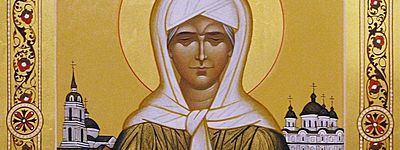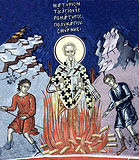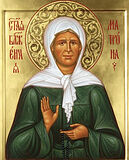 Hieromartyr Polycarp, bishop of Smyrna (167). Finding of the Relics of St. Matrona of Moscow (1998)
Hieromartyr Polycarp, bishop of Smyrna (167). Finding of the Relics of St. Matrona of Moscow (1998)
St. Alexander, founder of the Monastery of the Unsleeping Ones, Constantinople (ca. 430). Sts. John, Antioch, Antoninus, Moses, Zebinas, Polychronius, Moses (another), and Damian, ascetics near Cyrrhus (5th c.). St. Polycarp, monk, of Bryansk (1620-1621). St. Nazarius, abbot of Valaam Monastery (1809). St. Seraphim (Zenobius), schema-metropolitan of Tetritskaro, Georgia, monk of Glinsk Monastery (1985).
New Hieromartyr Michael Edlinsky, archpriest, of Kiev (1938). New Hieromartyr Nicholas Dmitrov, archpriest, of Zavidovo (Tver) (1938).
Virgin-martyr Martha at Astorga (Spain) (251). 73 Martyrs of Sirmium under Diocletian (303). St. Gorgonia (372), sister of St. Gregory the Theologian. Martyrs Syncrotas, Antigonus, Rutilus, Libius, Senerotas and Rogatianus, at Sirmium (4th c.). St. Florentius, confessor, of Seville (ca. 485). St. Felix, bishop of Brescia (ca. 650). St. Jurmin, prince, of East Anglia (653). St. Mildburga, abbess of Wenlock (715). St. Boswell (Boisil), abbot, of Melrose (ca. 661). St. John Theristes (the Harvester) of Stylos in Calabria (11th c.). St. Damian of Esphigmenou, Mt. Athos (1280). St. Cosmas of Zographou, Mt. Athos (1281). St. Moses, monk of White Lake (1480). New Monk-martyr Damian of Philotheou and Kissavos, at Larissa (1568). New Hieromartyr Lazarus of the Peloponnese (ca. 1618).
Repose of Archimandrite Agapit (Belovidov) of Optina Monastery (1922) and Elder Sabbas (Stavrobouniotes) of Cyprus (1985).
Wednesday.
When Moses and Aaron began to intercede
before Pharaoh to let their people go, the answer to this
was increased work for oppressed Israelites, to the point
that they raised an outcry against their intercessors:
ye have made our savour to be abhorred in the eyes of
Pharaoh (Ex. 5:21). This is exactly what the soul of a
repentant sinner experiences. When the fear of God and
one’s conscience—the inner Moses and
Aaron—begin to inspire a soul to finally rise up
onto its feet and shake off the yoke of sinful slavery,
joy passes through all of its members. But the enemy does
not sleep; he heaps mountains of mental
obstacles—thoughts that sin is insurmountable, and
brings in fear from all sides—fear for one’s
prosperity, for external relationships, for one’s
influence, even for one’s life. It even happens that
one stops having only just begun. Be inspired brother!
The Lord of hosts shall be exalted in judgement, and
God that is holy shall be sanctified in righteousness
(Is. 5:16). God is stronger than the enemy. Cry out to
Him, and you will hear the same thing that Moses heard
then: Now shalt thou see what I will do to Pharaoh
(Ex. 6:1).
The enemy does not have power over a
soul; he only can frighten it with illusory terrors. Do
not give in, endure, go forward courageously, saying to
yourself: I will not give in even unto death, and I will
go bravely wherever the Lord calls me, with the spirit of
repentance which now acts in me.


![]() Hieromartyr Polycarp, bishop of Smyrna (167). Finding of the Relics of St. Matrona of Moscow (1998)
Hieromartyr Polycarp, bishop of Smyrna (167). Finding of the Relics of St. Matrona of Moscow (1998) 

















